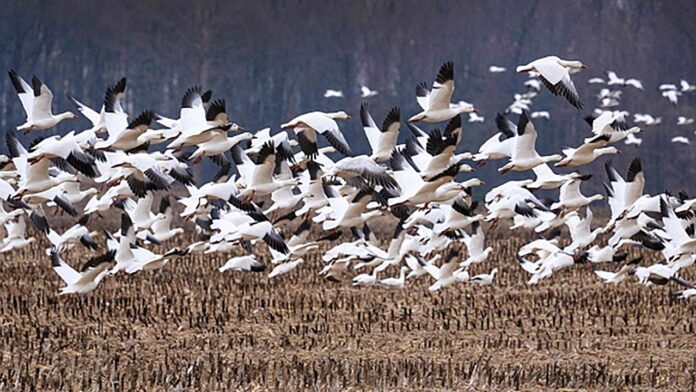The H5N1 strain of avian influenza is significant due to its unique features and potential to cause a pandemic. The article covers the emergence and spread of H5N1, the challenges in controlling its transmission among humans, its impacts on the poultry industry, and the global response to H5N1.
The article highlights the need for continued monitoring and management of H5N1 to prevent a pandemic and protect food security and the economy.
A University of Maryland-led team has found that slowing the spread of deadly bird flu in North America requires unprecedented levels of coordination at regional and national levels.
The study also discovered a shift from seasonal to year-round infections and a more significant impact on wild birds, indicating that H5N1 may become endemic and pose risks to food security and the economy. The paper, published in Conservation Biology, shows that the highly pathogenic disease is more complex to contain than the less contagious low pathogenic disease that the poultry industry has dealt with for decades.
“We’ve been dealing with low pathogenic avian influenza for decades in the poultry industry, but this is different,” said Jennifer Mullinax, assistant professor in the UMD Department of Environmental Science and Technology and a co-author of the study. The low-pathogenic disease is less contagious and easier to contain than the highly pathogenic variety.
She said, “This high pathogenic virus is wiping out everything in numbers that we’ve never seen before. This paper illustrates how unprecedented it is and describes what we think is coming. It’s a call to arms saying we can’t afford to address this from our silos. Federal agencies, state agencies, the agriculture sector, and wildlife management will all have to deal with this together because we can’t afford to.”
A team of researchers analyzed five different data sources on the incidence of highly pathogenic avian influenza in wild birds and poultry, focusing on the USA and Canada as well as a global database from 2014 through early 2023.
Their findings indicate that H5N1 is different from other avian influenza strains, posing new challenges due to its impact on wild birds and its potential to become endemic, potentially threatening food security and the economy. The team highlights the need for unprecedented levels of coordination at regional and national scales to slow the spread of H5N1.
Johanna Harvey, a postdoctoral researcher at UMD and lead author of the study, said, “Unlike H5N8, this disease is heavily impacting wild birds, It’s difficult to estimate how many birds are truly affected across wild populations, but we’re seeing dramatic disease impacts in raptors, sea birds and colonial nesting birds. And we now have the highest amount of poultry loss to avian influenza, so this is a worst-case scenario.”
Highly pathogenic avian influenza virus (HPAIV) H5N1 was introduced in North America in late 2021 through migratory birds and has resulted in an unprecedented spread across poultry, wild birds, and mammals. The virus was introduced during Europe’s most significant epidemic season, where it may now be endemic.
The spread of the virus has now expanded into Mexico, Central, and South America. The team of researchers analyzed FAO’s EMPRES-i+ database to investigate the global changes in confirmed detections in wild birds and poultry and collated publicly available data across USA and Canadian federal sources to examine the 2021 introduction and spread in North America.
The team found that the unique magnitude of the North American H5N1 spread indicates the need for effective decision framing to prioritize management needs and scientific inquiry. The spread of H5N1 has detrimental effects on wildlife, agriculture, and potentially human health. The team offers a reframing of HPAIV disease response towards a decision analytical context to guide scientific prioritization as a potentially valuable change in focus.
A University of Maryland-led team studying the spread of H5N1 bird flu in North America found a shift to year-round infections and a more significant impact on wild birds, potentially posing risks to food security and the economy. The study’s authors recommend unprecedented levels of coordination at regional and national scales to slow the virus’s spread.
They suggest a management approach based on Structured Decision-Making, similar to how humans deal with pandemics. The research team hopes their work will bring together key players to consider the next steps.
The study used a combination of five different data sources to analyze the incidence of highly pathogenic avian influenza H5N1 in wild birds and poultry in North America and globally from 2014 to early 2023. The data sources included official disease reporting, surveillance programs, scientific literature, online media, and social media.
The researchers used statistical modeling and trend analysis to identify patterns and changes in the spread and impact of the virus over time.
The study also employed Structured Decision-Making, a method for decision science, to develop management approaches and recommendations for addressing the disease. The materials used in the study were the various data sources, software for data analysis and modeling, and the research team’s expertise.
The study’s conclusion highlights that the changing dynamics of the highly pathogenic avian influenza H5N1 in North America require unprecedented levels of coordination and management at regional and national scales. The shift from seasonal to year-round infections and the far more significant impact on wild birds suggests that H5N1 will likely become endemic, posing risks to food security and the economy.
The researchers recommend a management approach based on Structured Decision-Making, which involves identifying relevant individuals with an interest or expertise in the issue and establishing measurable goals and actions.
The study emphasizes the need for federal agencies, state agencies, the agriculture sector, and wildlife management to work together to address this issue.
Journal Reference:
- Harvey, J. A., Mullinax, J. M., Runge, et al. The changing dynamics of highly pathogenic avian influenza H5N1: Next steps for management & science in North America. Biological Conservation. DOI: 10.1016/j.biocon.2023.110041
